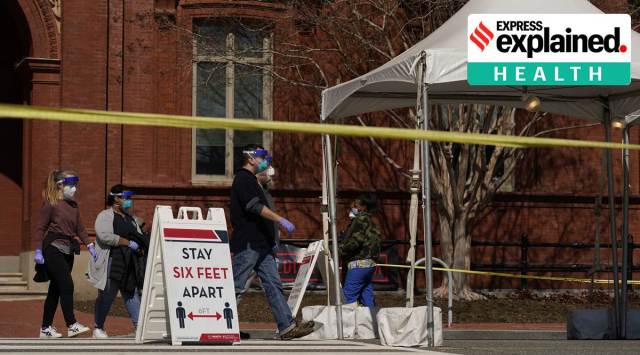New research: With masks on, gap of 3 ft as effective against Covid-19 as 6 ft
The study comes at a time when Massachusetts state officials are signalling it’s almost time to send all school-aged children back to the classroom.
 In Washington, DC. Six feet is the standard protocol in most countries. (AP)
In Washington, DC. Six feet is the standard protocol in most countries. (AP)Health authorities of most countries prescribe a minimum separation of 2 metres, or 6 feet, as between two persons to restrict the spread of Covid-19. What changes if both persons are wearing a mask?
A study led by physician-researchers of Beth Israel Deaconess Medical Center (BIDMC), under Harvard Medical School, has investigated that, and found that with masks on, and in a school setting in Massachusetts, 3 feet works as well as 6 feet. Their study is published in the journal Clinical Infectious Diseases.
The study comes at a time when Massachusetts state officials are signalling it’s almost time to send all school-aged children back to the classroom. It is a retrospective, state-wide cohort study, in which the researchers compared the rates of Covid-19 cases in students and staff in Massachusetts public schools among districts with universal mask mandates but different physical distancing requirements.
The team found no substantial difference in the number of cases of Covid-19 among either students or staff in school districts that implemented a distancing policy of 3 feet versus 6 feet between students. The findings suggest that lower physical distancing policies can be adopted in school settings with masking mandates without negatively impacting student or staff safety.
In a statement on the research, BIDMC quoted lead author Dr Polly van den Berg as saying: “Prior studies have not directly compared the impact of different physical distancing policies among students attending in-person school. This research, which found no substantial difference in the number of cases among either students or staff in school districts that implemented a distancing policy of 3 versus 6 feet between students, is important because many school buildings have physical infrastructure that cannot accommodate 6 feet of distancing and bring all (or most) students back into the classroom.”
Van den Berg and colleagues looked at publicly available data from 251 Massachusetts school districts, encompassing 537,336 students and 99,390 staff who attended in-person instruction during a 16-week study period from September 2020 to January 2021.
Using a combination of information — including individual district infection control plans, the number of infections reported to the Commonwealth by districts, and community rates of Covid-19 from a non-partisan, not-for-profit data dashboard — the scientists found no significant difference in the rate of Covid-19 cases among students and staff in districts that mandated 6 feet of distancing versus in districts that mandated 3 feet of distancing.
The team’s findings also showed that, in general, schools had lower overall rates of infection than their surrounding communities, lending support to the idea that in-person learning is not a major driver of the pandemic.
— Source: Beth Israel Deaconess Medical Center/Harvard Medical School
- 01
- 02
- 03
- 04
- 05






































